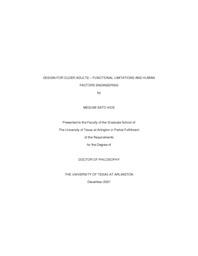
ATTENTION: The works hosted here are being migrated to a new repository that will consolidate resources, improve discoverability, and better show UTA's research impact on the global community. We will update authors as the migration progresses. Please see MavMatrix for more information.
Show simple item record
| dc.contributor.advisor | Imrhan, Sheik | |
| dc.creator | Hice, Megumi Sato | |
| dc.date.accessioned | 2022-01-25T18:22:12Z | |
| dc.date.available | 2022-01-25T18:22:12Z | |
| dc.date.created | 2021-12 | |
| dc.date.issued | 2021-12-13 | |
| dc.date.submitted | December 2021 | |
| dc.identifier.uri | http://hdl.handle.net/10106/30210 | |
| dc.description.abstract | Background: Throughout the aging process, people experience changes in functional ability and such changes can happen in physical and mental functions. As a result, older adults develop limitations in their capabilities to perform daily activities. Although many studies have done to identify functional limitations for elderly, many older adults still face negative consequences in daily living conditions due to their functional declines. One of the possible causes may be a lack of feedback or participations of elderly users in the design process. Other reason could be a lack of consideration to identify the needs for a specific task associated with daily activities.
Methods: This research aimed to determine the associations between specific tasks and functional declines utilizing the perspective of the elderly via an opinion survey and a focus group study. Seven daily activities (bathing or showering, dressing, preparing meals, housekeeping, medication adherence, using a computer, and using a cellphone) were identified, and opinion survey was designed to ask specific tasks of each activity based on the functional categories for human factors.
Findings: The results identified specific tasks that are associated with difficulty in performing daily activities. Environmental conditions to improve design to ease the difficulty of performing tasks by older adults were proposed, including bathroom space, kitchen layout, furniture, and consumer products. This study shows that, despite the accumulated knowledge and efforts to improve the living environment over the decades, these problems are still prevalent. Two important aspects of this study are new: 1) it elucidates difficulties people face in their actual living environment from their own point of view, and 2) it shows specific relationships between activities or tasks perceived as difficult, by the elderly, and their physical and mental capabilities. While most of the older adults seem to be satisfied with their environment a small, but significant, percentage find the environment still too challenging. | |
| dc.format.mimetype | application/pdf | |
| dc.language.iso | en_US | |
| dc.subject | Living environment | |
| dc.subject | Elderly people | |
| dc.subject | Human factors design | |
| dc.subject | Functional limitations | |
| dc.subject | Daily activities | |
| dc.subject | ADL | |
| dc.subject | IADL | |
| dc.subject | Online survey | |
| dc.subject | Focus group | |
| dc.title | DESIGN FOR OLDER ADULTS – FUNCTIONAL LIMITATIONS AND HUMAN FACTORS ENGINEERING | |
| dc.type | Thesis | |
| dc.degree.department | Industrial and Manufacturing Systems Engineering | |
| dc.degree.name | Doctor of Philosophy in Industrial Engineering | |
| dc.date.updated | 2022-01-25T18:22:13Z | |
| thesis.degree.department | Industrial and Manufacturing Systems Engineering | |
| thesis.degree.grantor | The University of Texas at Arlington | |
| thesis.degree.level | Doctoral | |
| thesis.degree.name | Doctor of Philosophy in Industrial Engineering | |
| dc.type.material | text | |
| dc.creator.orcid | 0000-0003-2399-5349 | |
Files in this item
- Name:
- HICE-DISSERTATION-2021.pdf
- Size:
- 9.302Mb
- Format:
- PDF
This item appears in the following Collection(s)
Show simple item record


